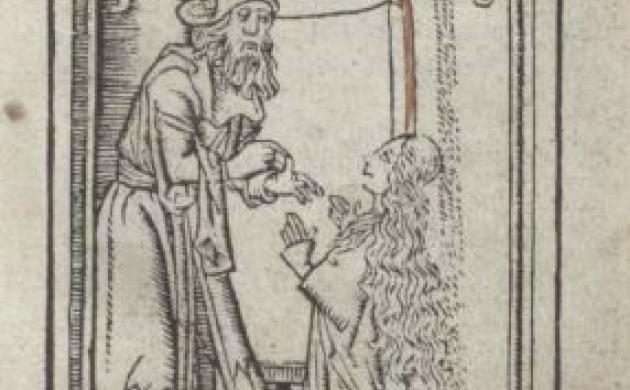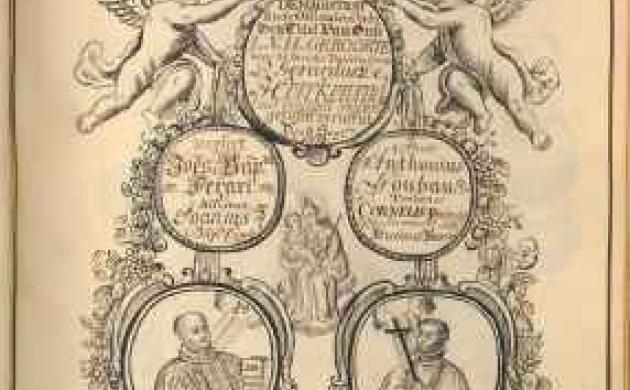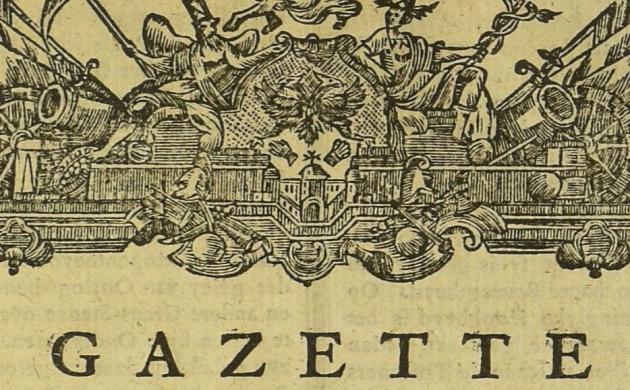Marie-Charlotte Le Bailly
Curator early printed books and manuscripts
On 12 March 2020, only a day before the Federal Government announced the general lockdown, the curators of early printed books were able to examine this during the viewing days at the auction house in Bruges. However, the book auction was postponed because live gatherings in the auction room were no longer allowed due to the sanitary measures. Eventually, the auction house organised an online auction on 15-16 May 2020. The Hendrik Conscience Heritage Library bid by correspondance and won its battle. Lot 722 was hammered out at 3200 euro (+ auction fees).

Titlepage Hier worden verhaelt vele wonderbaere gheschiedenissen, anonymous, ca. 1733. Foto: Victoriano Moreno
The title page is beautifully decorated in washed ink and represents a little temple in baroque style with open tympan and Ionic pillars, on which sacred figures rest. The drawing is strongly reminiscent of the facades of baroque churches, such as the Carolus Borromeus Church in Antwerp – which is situated on the Hendrik Conscience square, just in front of the Heritage Library. At the bottom of the drawing a coat of arms is incorporated, in which a twill, flowers and towers or a canopy can be recognized. This coat of arms strongly resembles the coat of arms of the Antwerp Van Havre family.
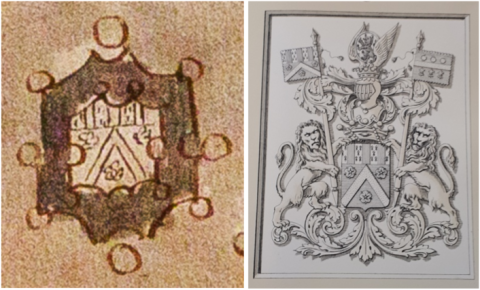
The coat of arms in the manuscript [on the left] and the coat of arms of the Van Havre family of Antwerp [on the right]
This intriguing manuscript is a hotchpotch of allegories, news items and all kinds of information. After the title page, the anonymous compiler begins with a beautifully drawn dedication to Our Lady of Halle. This is followed by 45 pages of 'Rymdichten en sinnebeelden gemaekt door Jacobus Moons' [Poems and allegories by Jacobus Moons]. An allegory [in Dutch: 'zinnebeeld'] is a kind of metaphor or imagery which portrays an abstract concept or morality by means of a concrete figure, such as an animal or a person. The compiler copied nineteen of these allegories by Jacobus Moons, 'Sedelyck vermaeck tonneel: verthoonende door sinne-beelden den leersamen handel van de onredelijcke dieren aen de verkeerde en beest-aerdighe werelt op-gherecht van verscheyden soo Griecksche, als Latijnsche schrijvers' (Antwerp, Michiel Knobbaert 1675, digitally available via Ghent University Library), in which twenty-five allegories can be found.
Why the adoration of our chronicler for the Black Madonna? This manuscript raises numerous questions and calls for more in-depth investigation. Who dares?
A good example is the second allegory, 'Vertoonende den handel tusschen den olijfboom, en andere boomen, hier uijt leerende dat den eersughtigen mensch tot den val comt, ende diesvolghens, dat de eer moet verstooten worden' [Showing the trade between the olive tree and other trees, learning therefrom that an ambitious person cometh to the fall, and that hubris must be rejected]. In other words, the imagery of the olive tree teaches us that pride comes before the fall, as the wise King Solomon said in the Bible (Proverbs 16:18). Jacobus Moons (1639-1721) was a canon at St Michael's Abbey in his native Antwerp. He wrote several spiritual and poetic works with allegories, each one entitled 'Sedelycke ...' ['Moral ...']. He dedicated these works to Gerardus Knyff (†1686), abbot of St Michael's Abbey in Antwerp. See for example Jacobus Moons, Sedelycken vreughden-bergh (Antwerp, Hendrick van Dunwalt 1682, H 83673:3).
The 'zinnebeelden' in the manuscript are followed by over five hundred pages of 'Ongehoorde chroniicke waer in te vinden siin wondere historien' ['Unheard of chronicle in which amazing histories can be found']. Like the title page, this title includes an chronogram for the year 1733, but the handwritten chronicle continues until 1745. Among other things, the chronicle contains the following:
- 'Verscheyde antiquiteyten van de stadt Brussel anno 974' (p. 53-79);
- a broad selection of news items from the European capitals in the period 1725 to 1745, filed by year (with a cartouche for each new year) (p. 80-466);
- all kinds of chronicles, obituaries, anniversaries, memorabilia and ceremonies;
- 'Brabantsch chronycke ende vele outheden voorgevallen' (p. 467-479);
- descriptions of various cities and countries (p. 480-544).
The manuscript ends with a ‘Corte beschrijvinghe van alle gedierten, vogelen, visschen uijt Plinius’ [‘Short description of all animals, birds and fish from Plinius’]. Finally two printed texts about processions in Mechelen and emblematic exhibitions in the Jesuit Church in Antwerp (i.e. the Carolus Borromeus Church) are bound in convolute:
- Vreugde-tekenen by wyse van omme-ganck op de kermisse der stadt ende provincie van Mechelen, den 8. en 9. julii 1737;
- and Kort verhael van het konstig verciersel der kerke van het professen-huys der societeyt Jesu binnen Antwerpen, op de solemniteyt der canonizatie van de heyligen Aloysius Gonzaga ende Stanislaus Kostka (Antwerpen, Jacobus van Gaesbeeck 1727).
Who is the anonymous compiler of the chronicle? We can only guess. At first glance he does not seem to make himself known anywhere, but from his choice of marvellous news and anecdotes a clear preference emerges for religious ceremonies and events in Brabant, especially Brussels and Antwerp. With some Antwerp pride we first look for his origins in the direction of an Antwerp milieu. After all, some elements from the manuscript seem to point to (the circles around) Saint Michael's Abbey in Antwerp, such as the coat of arms on the title page and the emblems of Jacobus Moons. And then there is a lost mark of provenance that seems to point in the direction of the Van Havre family in Antwerp. On the cover page of the convolute, there are still very vague traces of ink of a removed ex-libris, which seems to show many similarities with the ex-libris of the bibliophile.
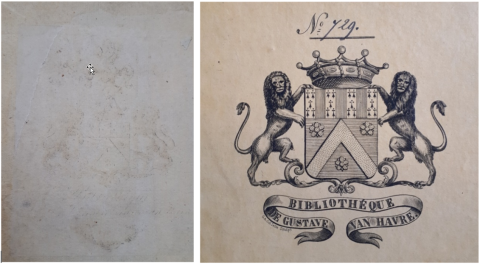
The removed ex libris in the manuscript [on the left] and one of the ex libris of Gustave Van Havre [on the right]
But does hubris not lead us to the fall? Although these clues seem to lead to an Antwerp milieu, a random comparison between the news items in the manuscript and those in the Gazette van Antwerpen (volumes 1719-1804 are available online) in the years 1736 and 1740 already shows few similarities. Our anonymous compiler therefore collected his news items from a different source. Should we look for him in Flemish Brabant? And what to say about his adoration of the Black Madonna of Halle? Could our chronicler be a clergyman from the Brussels area? In conclusion, this manuscript raises a lot of questions and calls for more in-depth research. Who dares?

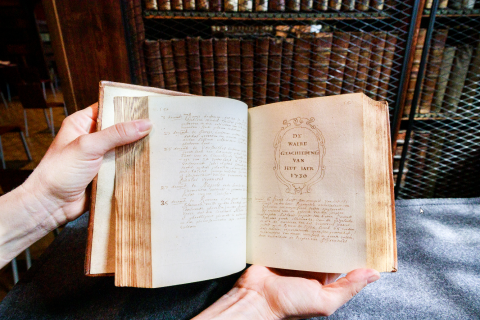
Photographs: Victoriano Moreno
Bibliography
- Luc Duerloo, ‘Het blazoen ontsmet. Adellijke heraldiek als toe-eigening van eer en deugd, 1550-1750’, BMGN - Low Countries Historical Review 123:4 (2008), pp.633–654, via DOI.
- Alfons Goovaerts, La famille Van Havre: histoire et généalogie (Antwerpen 1882).
- 700 jaar familie van Havre (Wijnegem 2004).
- Pierre Delsaerdt, Bibliofilie en publiek-private samenwerking: de veiling-Van Havre en de start van het Bestendig Dotatiefonds, 1905 (Antwerpen 2008).
- Renée Cambré, De veiling-Gustave van Havre, en het mecenaat ten gunste van de Stadsbibliotheek en het Museum Plantin-Moretus te Antwerpen, 1905 (Antwerpen 2008).
- Pierre Delsaerdt en Dries Vanysacker, Boeken erven en verwerven: de privébibliotheken van de Antwerpse kanunnik Petrus Knyff (1713-1784) en zijn vader Jacobus (1681-1756), De achttiende eeuw: documentatieblad van de Werkgroep achttiende eeuw 30 (1998) pp. 79-86.



